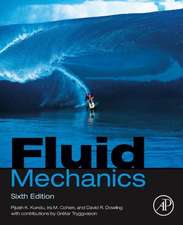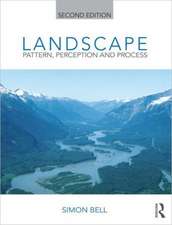Concepts & Applications of Finite Element Analysis 4e (WSE)
Autor RD Cooken Limba Engleză Hardback – 30 oct 2001
Preț: 1245.40 lei
Preț vechi: 1518.78 lei
-18% Nou
238.34€ • 247.91$ • 196.76£
Carte în stoc
Livrare din stoc 05 martie
Specificații
ISBN-10: 0471356050
Pagini: 736
Ilustrații: index
Dimensiuni: 178 x 254 x 42 mm
Greutate: 1.32 kg
Ediția:4th Edition
Editura: Wiley
Locul publicării:Hoboken, United States
Public țintă
Mechanical engineers, civil engineers.Descriere
LEARN FINITE ELEMENT THEORY AND HOW TO APPLY IT This book is an accessible introduction to finite element analysis.
The exposition moves gradually from simplke concepts to more advanced theory, with the goal of making competent applications based on sold understanding. In addition to theory, considerable attention is given to practical matters: modeling for finite element analysis, checking computed results for errors, and revising an analysis as needed.
FEATURES:
- Basic theory is clearly explained.
- Includes over 500 analytical problems.
- Structural mechanics is emphasized.
- Dynamics, nonlinearity, and heat transfer are treated.
- Includes application examples with solution critiques.
ACCOMPANYING SOFTWARE:
Any finite element analysis software can be used with this book.
However, VisualFEA (ISBN 0471–21207–5) developed by Intuitive Software, Inc. is available from Wiley for packaging with this book.
VisualFEA is exceptionally easy–to–use and powerful finite element analysis software with computer–based training tools for teaching and learning the finite element method. For both Windows and Mac operating systems. (For those seeking more emphasis on implementation, Fortran coding is available as described in the Preface.)
Textul de pe ultima copertă
LEARN FINITE ELEMENT THEORY AND HOW TO APPLY IT This book is an accessible introduction to finite element analysis.
The exposition moves gradually from simplke concepts to more advanced theory, with the goal of making competent applications based on sold understanding. In addition to theory, considerable attention is given to practical matters: modeling for finite element analysis, checking computed results for errors, and revising an analysis as needed.
FEATURES:
- Basic theory is clearly explained.
- Includes over 500 analytical problems.
- Structural mechanics is emphasized.
- Dynamics, nonlinearity, and heat transfer are treated.
- Includes application examples with solution critiques.
ACCOMPANYING SOFTWARE:
Any finite element analysis software can be used with this book.
However, VisualFEA (ISBN 0471–21207–5) developed by Intuitive Software, Inc. is available from Wiley for packaging with this book.
VisualFEA is exceptionally easy–to–use and powerful finite element analysis software with computer–based training tools for teaching and learning the finite element method. For both Windows and Mac operating systems. (For those seeking more emphasis on implementation, Fortran coding is available as described in the Preface.)
Cuprins
Notation.
Introduction.
One–Dimensional Elements, Computational Procedures.
Basic Elements.
Formulation Techniques: Variational Methods.
Formulation Techniques: Galerkin and Other Weighted Residual Methods.
Isoparametric Elements.
Isoparametric Triangles and Tetrahedra.
Coordinate Transformation and Selected Analysis Options.
Error, Error Estimation, and Convergence.
Modeling Considerations and Software Use.
Finite Elements in Structural Dynamics and Vibrations.
Heat Transfer and Selected Fluid Problems.
Constaints: Penalty Forms, Locking, and Constraint Counting.
Solid of Revolution.
Plate Bending.
Shells.
Nonlinearity: An Introduction.
Stress Stiffness and Buckling.
Appendix A: Matrices: Selected Definition and Manipulations.
Appendix B: Simultaneous Algebraic Equations.
Appendix C: Eigenvalues and Eigenvectors.
References.
Index.
Notă biografică
Robert D. Cooke received his Ph.D. in Theoretical and Applied Mechancis from the University of Illinois in 1963. Since then he has been at the University of Wisconsin–Madison, where he is now a professor in the Department of Engineering Physics. His interests include stress analysis and finite element methods. In addition to the present book, he is author of Finite Element Modeling for Stress Analysis (Wiley, 1995) and Advanced Mechanics of Materials (2nd Edtion, Prentice Hall, 1999, with Warren C. Young). David S. Malkus received his Ph.D. from Boston University in 1976. He spent two years at the National Bureau of Standards and seven years in the Mathematics Department of Illinois Institute of Technology. He is now Professor of Engineering Mechanics at the Univrersity of Wisconsin–Madison. His research interests concern application of the finite element method to problems of structural and continuum mechanics, in particular the flow of non–Newtonian fluids. He is a member of the Rheology Research Center (University of Wisconsin–Madison) and the Society of Rheology.
Michael E. Plesha received his B.S. from the University of Illinois at Chicago, and his M.S. and Ph.D. degrees from Northwestern University, the Ph.D. degree in 1983. He has been a faculty member in the Department of Engineering Physics at the University of Wisconsin–Madison since 1983 where he is Professor of Engineering Mechanics. His research areas include constitutive modeling and finite element analysis of contact–friction problems, transient finite element analysis, and discrete element methods.
Robert J. Witt received his Ph.D. in Nuclear Engineering from the Massachusetts Institute of Technology in 1987. He is now an associate professor in the Department of Engineering Physics at the University of Wisconsin–Madison. His research interests are in computational methods of fluid and solid mechanics, with particular application to nuclear systems.









